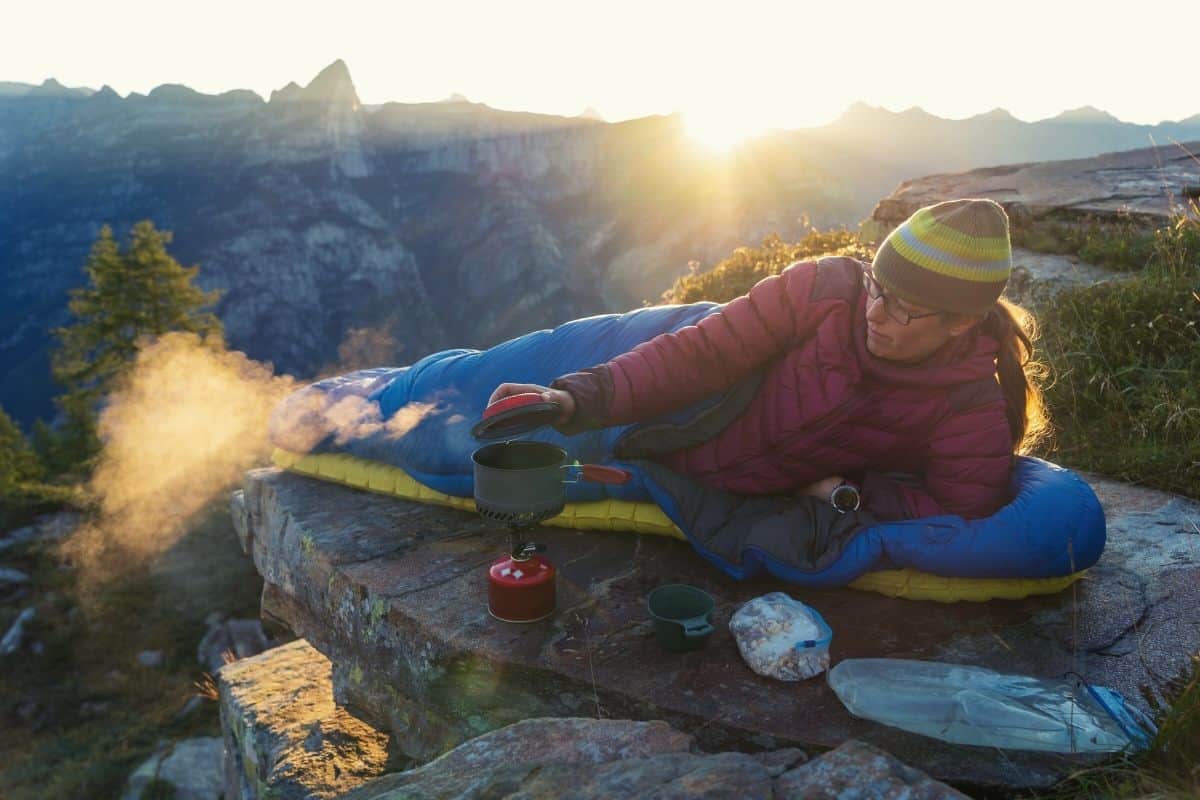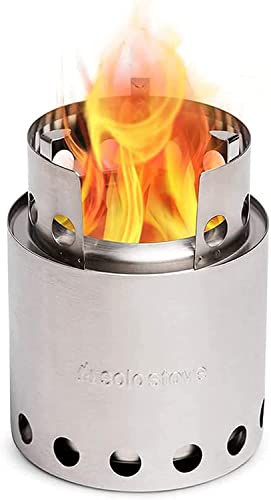If you’re preparing for a backpacking trip, cravings for hot evening meals and cups of strong, caffeinated drinks could become an issue. Luckily, having a dependable, high-performing camping stove can solve that problem. As luck would have it, our reliance on these stoves has led us to extensively try and test numerous options over the years.
This year, we’ve tested a fresh batch of newcomers and upgraded models. Whether you prefer wood or multi-fuel stoves, all-in-one systems, or ultralight canister models, our guide has options for everyone! Topping the list is the MSR PocketRocket 2, with other contenders including the Jetboil FlashBRS 3000T, Jetboil MiniMo, MSR WhisperLite, Solo Stove Lite, MSR WindBurner, Soto Amicus, and the Primus Essential Trail.
We also offer guidance on how to select your camping stove. You’ll have to consider the fuel type and whether you prefer an integrated or non-integrated canister model. Additionally, stove efficiency, cooking controls, and practical features are crucial factors to ponder when picking the ideal model for your needs.
Best Camp Stove For Backpacking: Recommendations
-
Editor’s Choice:
MSR PocketRocket 2
“An ultralight and ultra-compact canister stove that packs a mighty punch.” -
Best All-in-One System:
Jetboil Flash
“A super-convenient, streamlined, and speedy integrated system that boasts the best fuel efficiency and boil time of the bunch.” -
Best Ultralight:
BRS 3000T
“Weighing just 1 oz., this nano-sized backpacking stove is ideal for fast-and-light backcountry adventures.” -
Best All-in-One with Simmer Control:
Jetboil MiniMo
“A highly efficient, uber-convenient, and user-friendly integrated system that allows for more precise cooking than many of its all-in-one competitors.” -
Best Multi-Fuel Stove:
MSR WhisperLite
“This remote canister stove can burn on a wide variety of fuel types, making it the most versatile of the bunch and the top performer both in sub-zero conditions and at higher elevations.” -
Best Wood Stove:
Solo Stove Lite
“This remarkably well-designed alternative-fuel stove is a great option for long-term backcountry travel.” -
Best for Car Camping:
MSR WindBurner
“This one’s a little on the heavy and pricey side, but was a top performer in strong winds and among the most fuel-efficient in our review.” -
Best Value:
Soto Amicus
“A simple but highly effective and reliable canister stove with excellent simmer control and push-button ignition.” -
Best Budget:
Primus Essential Trail Stove
“This canister stove is, in short, a slightly bulkier, heavier, and cheaper alternative to the PocketRocket 2 backpacking stove.”
Backpack Stoves For Camping by Category
Stoves under $50: MSR PocketRocket 2, BRS 3000T, Soto Amicus, and Primus Essential
Fastest boil time: MSR PocketRocket 2, BRS 3000T, Jetboil Flash, MSR WhisperLite, and Primus Essential
Lightest: MSR PocketRocket 2, BRS 3000T, Soto Amicus, and Primus Essential
What Are This Year’s Best Backpacking Stoves?
The top backpacking stove models for this year, with the MSR PocketRocket 2 leading the pack, are shown in the list below.
- MSR PocketRocket 2
- Jetboil Flash
- BRS 3000T
- Jetboil MiniMo
- MSR WhisperLite
- Solo Stove Lite
- MSR WindBurner
- Soto Amicus
- Primus Essential Trail
MSR PocketRocket 2
Editor’s ChoiceFuel Type: Canister ⸱ Weight: 2.6 oz. (minimum); 3.7 oz. (packaged) ⸱ BTUs: 8,200 ⸱ Boil Time: 3 mins 30 sec ⸱ Auto Ignition: No
The MSR PocketRocket 2 checks all the boxes for best backpacking gas stove: it’s reliable, lightweight, compact, boasts a quick boil time, and performs well in windy conditions.
This ultralight canister stove tips the scales at a tiny 2.6 oz. (3.7 oz. packaged), making it the second lightest on our list after the BRS 3000T. It also has an impressive boil time of just 3.5 minutes, takes up very little pack space thanks to its folding pot supports, and offers excellent simmer control.
The wind performance of ultralight canister stoves is, of course, notoriously poor. However, the PocketRocket 2’s WindClip wind protection and focused burner ensure you have a solid, steady flame even when conditions are particularly breezy.
Our review’s other canister stoves, the BRS 3000T, Soto Amicus, and Primus Essential Trail all provided the PocketRocket 2 with stiff competition. In the field, however, we found the PocketRocket 2 to be a better performer than all 3 in windy conditions and a more fuel-efficient stove than both the Amicus and the Primus Essential.
The only downsides to this backpacking stove are its lack of a push-button ignition and its poorer wind performance as compared to all-in-one systems, both of which are highly forgivable given its fair pricing and ultralight weight.
PROs
- Ultralight and compact
- Speedy boil time
- No priming needed
- WindClip wind protection
- Stable pot support
CONs
- No auto ignition
- Poorer performance in high winds, cold conditions, and at altitude
Bottom-Line: An ultralight, compact canister stove that offers decent wind performance and packs a surprisingly powerful punch given its tiny dimensions.
Jetboil Flash
Best All-In-One SystemFuel Type: Canister ⸱ Weight: 13.1 oz. ⸱ BTUs: 9,000 ⸱ Boil Time: 3 mins 20 secs ⸱ Auto Ignition: Yes
The Jetboil Flash, a top-selling backpacking stove for over a decade, claims our prize for best all-in-one system.
In addition to boasting a push-button igniter and thermochromic color-change heat indicator, it has a 1-liter insulated cooking cup with burly heat-proof handle and a fuel-canister stabilizer that helps to prevent spills on uneven terrain or in windy conditions.
The Flash’s boil time of 3 minutes and 20 seconds is also mightily impressive and makes it the second-fastest boiler in our review after the BRS 3000T.
But how does the Flash compare to our review’s other all-in-one systems, the JetBoil MiniMo and MSR WindBurner?
In a head-to-head with the MiniMo, the Flash came up trumps owing to its far speedier boil time, even if we appreciated the MiniMo’s simmer control for more precise heating.
And while the MSR WindBurner was more effective in windy conditions, its extra weight and heftier price tag meant we judged the Flash to be more suitable for backpacking and better value for money overall.
PROs
- User-friendly design
- Integrated pot/mug, heat exchanger, and burner
- Push-button ignition
- Fast boil time
- Heat indicator
CONs
- Heavy and bulky
- No simmer control
- Less efficient in windy conditions than other all-in-one systems
Bottom-Line: An expensive but powerful and efficient hiking stove that takes convenience to a whole new level. Ideal for dehydrated meals and basic boiling.
BRS 3000T
Best UltralightFuel Type: Canister ⸱ Weight: 1 oz. ⸱ BTUs: 9,200 ⸱ Boil Time: 2 mins 58 secs ⸱ Auto Ignition: No
If you’re an ounce-counter or looking for a featherweight backup stove then our favorite ultralight choice is the BRS 3000T.
This titanium-made mini camp stove weighs just 1 oz., but packs 9,200 BTUs and offers a highly impressive boil time of under 3 minutes, making it the most rapid boiler in our review.
Compared to our list’s other stoves in the “ultralight” category, the BRS 3000T makes a few compromises, as you might expect.
It’s a poorer performer than the PocketRocket 2, Soto Amicus, and Primus Essential in windy conditions, and also lacks a push-button ignition. However, it’s considerably cheaper than all three of these small canister stoves and still a good pick for solo campers or anyone else who’s short on pack space or averse to carrying too much weight.
PROs
- The price!
- Tiny packed size (it’s the smallest camping stove we know of!)
- Ultralight
- Speedy boil time
- Wide wingspan will accommodate even a large cook pot
CONs
- No push-button ignition
- Poor wind performance
Bottom-Line: Weighing just 1 oz. and boiling water fast, this ultralight backpack stove is a great pick for solo campers and thru-hikers keen to cut down on pack weight without compromising on boil time.
Jetboil MiniMo
Best All-In-One With Simmer ControlFuel Type: Canister ⸱ Weight: 14.6 oz. ⸱ BTUs: 6,000 ⸱ Boil Time: 4 mins 30 secs ⸱ Auto Ignition: Yes
The Jetboil MiniMo wins our award for the best all-in-one stove system with simmer control.
The MiniMo is, in short, a more elaborate version of the Jetboil Flash. Compared to the Flash, the MiniMo offers better functionality courtesy of its built-in temperature regulator and awesome simmer control. It has a shorter and wider build, which gives it slightly better stability than the Flash, and the wider diameter also makes it easier to eat directly from the pot with a spoon.
The Flash’s lower price and far speedier boil time (3.5 mins compared to the MiniMo’s 4.5 mins) mean it remains our favorite all-in-one system for simply boiling water for brews or dehydrated meals. However, the MiniMo is a better choice if you plan on cooking up more elaborate meals that require more precise temperature control.
Compared to the similarly priced MSR WindBurner, the MiniMo offers less impressive performance in windy conditions but is a fraction lighter and has the benefit of a push-button ignition.
PROs
- Fuel efficiency
- Ignition system
- Wind performance
- Simmer control
- Fuel canister stabilizer included
CONs
- Slow boil time
- Pricey
Bottom-Line: A compact integrated canister system with awesome simmer control and great fuel efficiency.
MSR WhisperLite
Best Multi-FuelFuel Type: Multi ⸱ Weight: 10.9 oz. ⸱ BTUs: 5,300 (LPG vapor); 10,300 (LPG liquid-inverted); 9,500 (white gas); 7,300 (kerosene) ⸱ Boil Time: 3 mins 30 secs (white gas); 4 mins 30 secs (kerosene) ⸱ Auto Ignition: No
The MSR Whisperlite is our recommended multi-fuel stove, providing increased versatility for use in all seasons and being adaptable for use with various fuel sources.
So far, our review has focused on isobutane/propane canister stoves, which are a great choice for general, three-season camping but less so when temps slump below the twenty-degree mark. But, if you plan on camping in cold conditions the most efficient backpacking stoves are those that run on liquid fuel and use an inverted/remote canister, like the MSR WhisperLite.
The WhisperLite can run on a variety of fuel types, including LPG, white gas, kerosene, and even unleaded auto fuel. This makes it by far the most versatile backpacking stove on our list and also a shoo-in for trips overseas, where it’s often tricky to find compatible fuel for screw-on canister stoves.
The WhisperLite may look a little complicated, but it’s actually very easy to use. All you do is connect your fuel bottle to the burner via the fuel line, light the flame, and you’re good to go.
At 10.9 oz., the WhisperLite is a little heavier than most other non-integrated stoves on our list and will weigh more than most all-in-one systems once you’ve added the weight of your pot. Its impressive cold-weather performance, however, makes it well worth those extra few ounces and our go-to for winter-camping trips regardless.
PROs
- Ideal for cold conditions and international travel
- Invertible/remote canister
- Runs on various types of fuel (unleaded gasoline, LPG, kerosene, white gas)
- Good boil time running on white gas
- Includes a fuel pump, windshield, heat reflector, instructions, and storage sack
CONs
- Expensive
- Quite heavy
Bottom-Line: A fuel-efficient, versatile, and compact stove that works with various types of fuel and boasts awesome wind protection and simmer control to boot. One of the most popular liquid-fuel stoves on the market.
Solo Stove Lite
Best Wood StoveFuel Type: Wood ⸱ Weight: 9 oz. ⸱ BTUs: N/A ⸱ Boil Time: 8-10 mins ⸱ Auto Ignition: Nope!
With its unique double-walled design, the Solo Stove Lite excels in the world of portable wood burning stoves.
Alternative fuel stoves for backpacking aren’t to everyone’s liking, granted. They have slower boil times, are bulkier than other types of non-integrated stoves, and using one means you stake the viability of a warm dinner or morning brew on being able to find an adequate supply of dry fuel (wood, twigs, and leaves) at camp.
Nevertheless, by allowing you to leave your gas canister or fuel bottle at home, they’re rightfully viewed as a practical alternative to canister or liquid-fuel models. If that is, you’re heading on a multi-day trip and need to keep pack weight to a minimum.
The Solo Stove Lite is far from being among the lightest or most compact stoves on our list. However, its double-walled construction and impressive boil time compared to other alternative-fuel stoves make it a winner if schlepping multiple canisters in your pack or restocking en route aren’t an option.
This may look like a fairly rudimentary, low-tech contraption, but there’s a lot more to it than first appearances suggest.
The Solo’s double-walled design and the air intake holes at the base create natural convection that allows it to recirculate warm air. The narrow cooking ring also focuses heat on the center of your pot whilst simultaneously acting as a windscreen, thereby improving burning efficiency.
Beneath the burning chamber, a wire grate allows oxygen to enter the device from below, which makes the biomass fuel burn faster and at hotter temperatures. Beneath that, a handy ashpan is included to simplify cleaning and prevent your fire from burning the earth below it.
The Solo can also function as a windshield and pot support for an alcohol stove, something we’d always recommend you carry as a backup if you have any doubts about being able to find enough biomass to get a blaze going on your wood-burner.
PROs
- Lightweight
- No need to carry fuel
- Compact
- Easy to use and maintain
- Doubles as a windshield for an alcohol burner
CONs
- No output control
- Dry fuel (twigs, sticks, leaves) required
- Wood stoves aren’t permitted in some national parks and wilderness areas
Bottom-Line: Although it takes a little longer to bring water to the boil, this wonderfully simple little backpacking stove is ideal for extended stays in the wilderness.
MSR WindBurner
Best For Car CampingFuel Type: Canister ⸱ Weight: 15.5 oz. ⸱ BTUs: 7,000 ⸱ Boil Time: 4 mins 30 secs ⸱ Auto Ignition: No
For car camping, the MSR Windburner is a top recommendation, providing enough benefits to make it a solid choice for those not overly concerned with every additional ounce in their pack.
If you’re looking for an all-in-one stove system with a little more nuance than the Jetboil Flash, or that performs a little bit better in windy conditions, then the MSR WindBurner is well worth a place on your shortlist.
Like our review’s other all-in-one systems, the WindBurner offers awesome fuel efficiency thanks to its use of a radiant burner, built-in heat exchanger, and an enclosed design that shields the burner from outside conditions. While a little pricier than the Jetboil Flash, it’s a far better performer in windy weather and includes simmer control for more precise cooking.
The Windburner also comes with a tripod-like canister stand that provides extra support and stability when you’re using it on uneven ground or in blustery conditions.
PROs
- Fuel-efficient
- Good simmer control
- Great in windy conditions
- Secure-locking insulated pot with handle
- Nesting components make it surprisingly packable
CONs
- Heavy
- Pricey
- Slowish boil time
Bottom-Line: An expensive and slightly heavy all-in-one system that atones for its heft and price tag with an effective windshield, versatile pot, great simmer control, and good fuel efficiency.
Soto Amicus
Best ValueFuel Type: Canister ⸱ Weight: 2.9 oz. (11.2 oz. with cook set) ⸱ BTUs: 11,000 ⸱ Boil Time: 4 mins 42 secs ⸱ Auto Ignition: Yes
The Soto Amicus is our top pick for the best value backpacking stove, boasting a compact size, lightweight build, and the added convenience of push-button ignition.
With a boil time of 4 minutes and 42 seconds, this pocket stove is the slowest of all the mini camp stoves on our list. It’s also a poorer performer in windy conditions than the PocketRocket 2 and nearly twice the price of the Primus Essential.
However, this folding camp stove is a little lighter than both of those options, has good simmer control, and boasts that potentially deal-making, convenience enhancing addon – a push-button ignition.
The Amicus also comes with a full cook set, including a 500ml pot for scrambling eggs, frying sausages, or sauteing onions, etc., and a 1,000ml pot for pasta, dehydrated meals, gruel, porridge, or other bulky fare.
PROs
- Affordable
- Simmer control
- Auto-ignition
- Spring-loaded pot-support legs
- Ultralight
CONs
- Slow boil time
- Less efficient in the wind than PocketRocket 2
Bottom-Line: A reliable, lightweight, and highly packable folding campfire stove that offers the added convenience of a push-button igniter.
Primus Essential Trail
Best BudgetFuel Type: Canister ⸱ Weight: 4 oz. ⸱ BTUs: 8,600 ⸱ Boil Time: 3 mins 30 secs ⸱ Auto Ignition: No
The Primus Essential Trial is our top budget pick, offering a similar performance to more expensive, high-end models.
The Essential Trail is the heaviest of the canister pocket stoves on our list, and also the bulkiest since the pot supports don’t fold up like those used on the PocketRocket 2, BRS 3000T, or Soto Amicus. However, it has the second speediest boil time of that bunch, offers better wind protection than the Amicus, and costs half the price of both the Amicus and the PR2.
Compared to other budget mini camping stoves we put to the test, this canister stove won our vote on account of its sturdier design, reliability, impressive boil time, precise flame control, and above-average performance in windy conditions.
PROs
- Cheap!
- Fast boil time
- Relatively lightweight
- Good flame control
- Built-in pot support doubles as wind protection
CONs
- Bulkier packed size than the PocketRocket 2, BRS 3000T, and Soto Amicus
Bottom-Line: An affordable, lightweight stove with wind-blocking pot supports and impressive simmer control.
How To Choose The Best Camping Stove For Backpacking?
There are a variety of factors to keep in mind when browsing for a backpacking stove, we’ve described the most important in the list below.
- Stove fuel types
- Integrated or non-integrated canister stove
- Water boil time & fuel efficiency
- Burner power: BTUs
- Weight & packability
- Integrated ignition system
- Simmer control
- Wind protection
- Cooking at altitude & in cold weather
- Stability
- Stove cooking at altitude or in cold weather
Stove Fuel Types
Stoves for backcountry cooking can use various fuel types. In the following list, we briefly explain each system type based on fuel used, helping you select the most appropriate option for your needs.
- Canister (Isobutane/Propane)
- Liquid-Fuel
- Alcohol
- Solid-Fuel (ESBIT)
- Wood-Burning
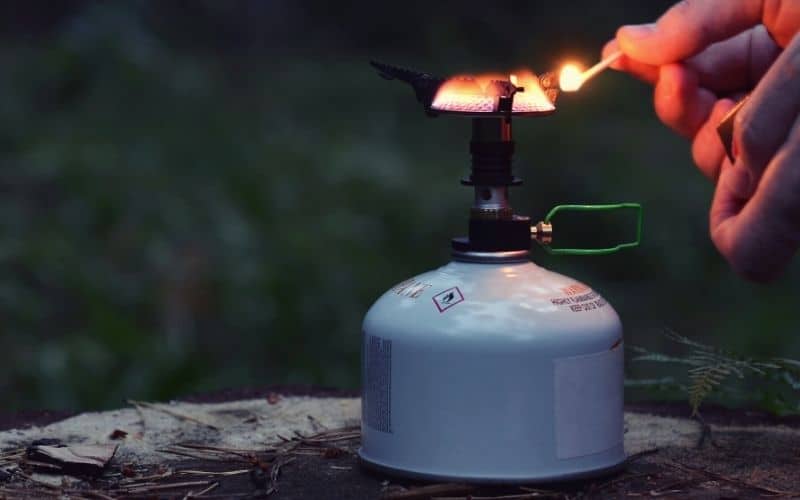
Canister (Isobutane/Propane)
There are three types of canister stoves: screw-on, remote (also known as “hose-fed”), and all-in-one systems, all of which connect to a gas canister, typically filled with isobutane and/or propane gas.
Screw-on and remote canister stoves are a popular choice with backpackers owing to their light-weight, quick boil times, user-friendly design, and tiny packed size.
Screw-on stoves consist of a simple burner that screws onto the top of a propane or isobutane fuel canister. Once attached, you simply turn the dial to release the fuel, light up with a match or push-button ignition, then begin cooking.
While not as fuel-efficient as all-in-one systems, canister stoves are far lighter and usually much cheaper, too. They’re also far more efficient than solid-fuel stoves and alcohol stoves.
Remote canister stoves connect the canister to the burner via a gas hose. Because these stoves are closer to the ground, they are usually more stable and burn better in windy conditions than screw-ins. On the downside, remote hose-fed systems are usually much bulkier and heavier.
All-in-one systems consist of a pot, burner, and heat reflector that attaches to the canister. Because they enclose the burner, these models heat faster with less fuel, making them the most fuel-efficient of the bunch.
The main downside to all canister-powered stoves is that the isobutane and propane fuel that they run on is expensive. The canisters are also heavy and bulky, and can’t be refilled, meaning they’re not the most eco-friendly option either. Isobutane and propane are also poor performers at altitude or in cold weather, and finding compatible canisters overseas can be tricky.
In our review, there are 3 integrated canister stoves (Jetboil Flash, MSR Windburner, Jetboil MiniMo), 1 remote canister (MSR WhisperLite), and 4 non-integrated canister stoves (MSR PocketRocket2, BRS 3000T, Soto Amicus, and Primus Essential Trail).
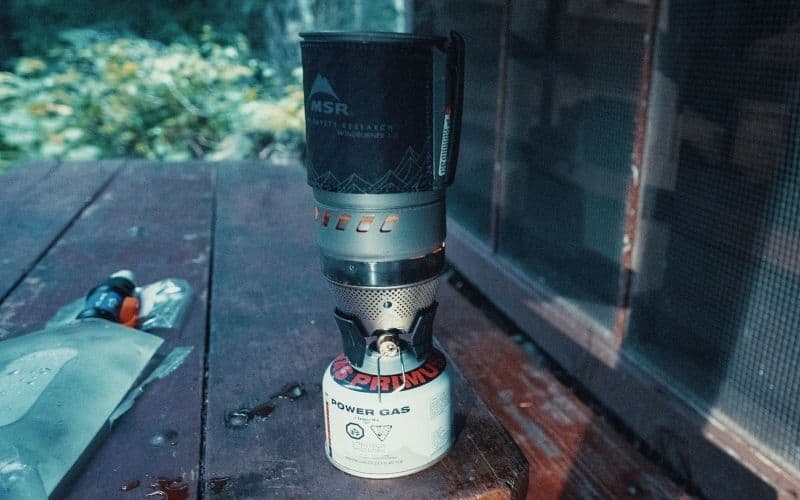
Liquid-Fuel
These stoves utilize liquid fuel canisters instead of compressed gas and can be more challenging to ignite since you have to pump the liquid fuel to vaporize it into a gas.
Most liquid-fuel stoves run on white gas, kerosene, LPG, or unleaded gas. These fuels are less expensive than isobutane/propane, but burn a little hotter, meaning you’ll go through fuel a bit quicker.
Liquid-fuel stoves aren’t the speediest option available, but their fuel efficiency and awesome cold-weather performance mean they’re great for longer trips and winter camping.
They’re also often a more suitable choice for trips overseas (finding compatible canisters for canister stoves is often a struggle in Asia, South America, and parts of Europe) and perform better at high altitudes than other fuel types.
One of the most appealing things about liquid-fuel stoves, for some, is that – unlike canister stoves – the bottles used with a liquid-fuel system can be refilled, thus reducing waste from spent fuel canisters.
The only downsides to liquid-fuel stoves are that they tend to be heavier and bulkier than other canister stoves, and also require regular cleaning and maintenance.
The MSR WhisperLite is the only liquid-fuel stove on the list. It is also compatible with different fuels, such as autogas, kerosene, and white gas.
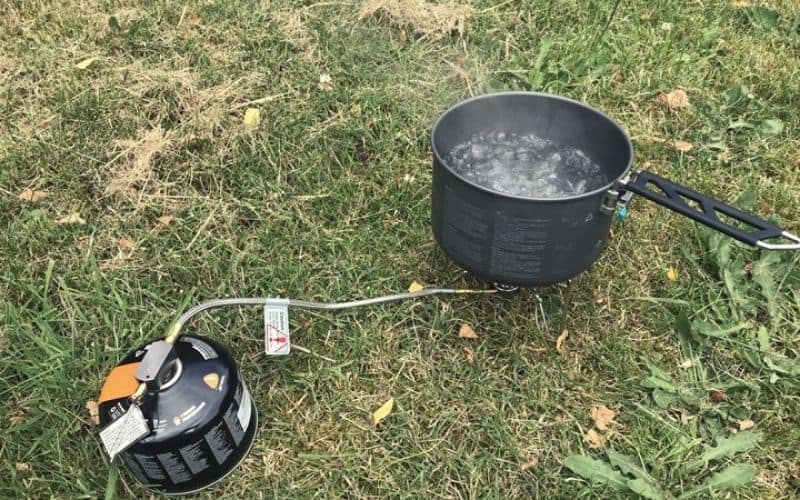
Alcohol
Alcohol stoves run on denatured alcohol and are particularly popular with thru-hikers and ultralight backpackers because they’re affordable, lightweight, easy to use, and very hard to break!
Fuel for this type of backpacking stove is also easily sourced and can usually be found in hardware stores or even in gas stations.
There are, however, several trade-offs for all of the above. Alcohol stoves don’t have any temperature control, cook slowly, and perform poorly in windy conditions, even with a windscreen. They also can’t be used in areas/campsites that prohibit open fires.
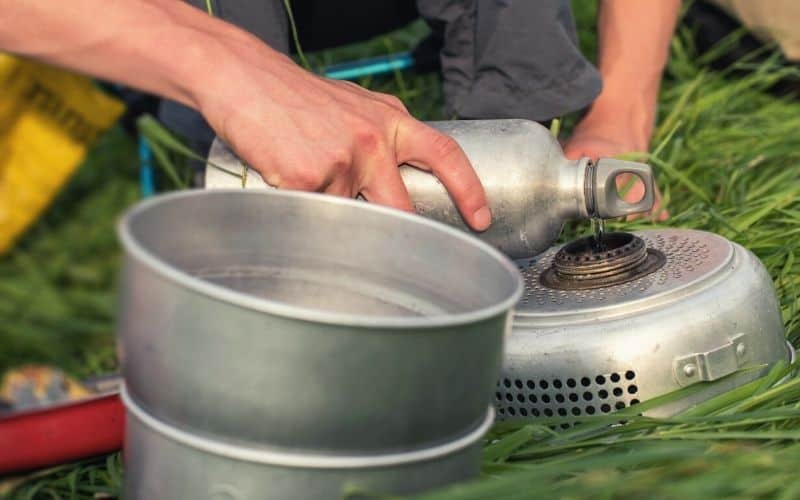
Solid-Fuel (ESBIT)
Solid-fuel (ESBIT) stoves are simple, ultra-compact, and lightweight running on small spirit tablets resembling standard domestic firelighters. While they are smokeless and energy-efficient, ESBIT fuel can be hard to find, pricey, prohibited in many national parks, and potentially toxic in poorly ventilated areas.
The tabs also excrete an unpleasant smell and are prone to leaving residue at the bottom of the pot.
Wood-Burning
Using a wood-burning stove involves doing things the old-fashioned way – gathering dried leaves, sticks, pinecones, and other deadwood materials and throwing these in the device as fuel.
While this has its benefits (no need to purchase or pack fuel!), boil times are lengthy, there’s no simmer control, and your foraged fuel is sure to leave grubby soot marks all over your cookware. As with ESBIT and alcohol stoves, the use of wood stoves is prohibited in many national parks and wilderness areas.
The only wood-burning stove system on our list is the Solo Stove Lite, which is lightweight and compact enough for multi-day trips but takes 8-10 minutes to boil a liter of water.
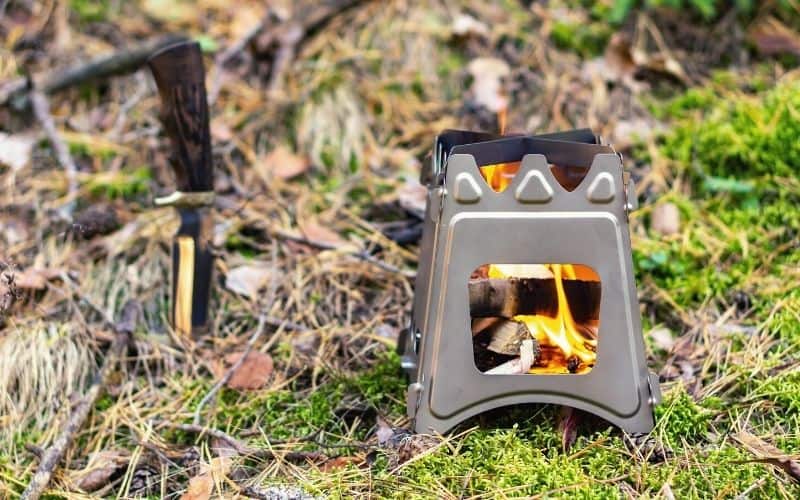
Integrated Or Non-Integrated Canister Stove?
The difference between non-integrated and integrated canister stove systems in terms of weight and performance is vast. Below, we’ve provided a summary of the advantages and drawbacks of both types of systems to aid your decision-making process.
Integrated Canister Stove System
- Integrated system includes everything needed for meal prep/boiling – a burner, heat exchanger, and pot
- More efficient than other systems, consume less fuel
- Some have built-in handles that allow you to use them as a mug
- Often lack simmer control, meaning they’re good for boiling water and cooking dehydrated meals, but not for more complicated culinary endeavors
Examples: Jetboil Flash, Jetboil MiniMo, MSR WindBurner.
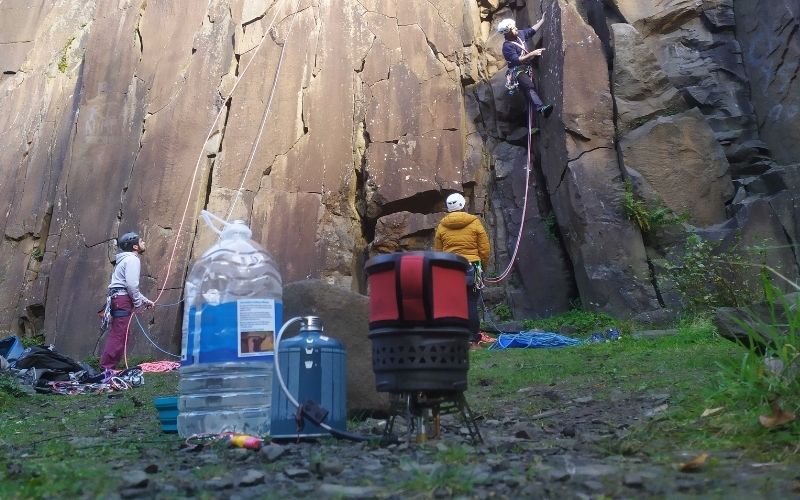
Non-Integrated Canister Stove System
- Non-integrated system consists of a burner only, meaning you’ll have to buy your cook set/pot and windscreen separately
- More versatile because you have the option to choose the size of pot you need
- Lighter and more compact than integrated systems
- Heat exchanger is not included
- Less stable and less efficient because the flames are exposed to the wind (using a windscreen or parking your *ss upwind of the burner helps!)
- Usually made of stainless steel or titanium – stainless steel is cheaper, titanium is lighter and has a higher strength rating
Examples: MSR PocketRocket2, BRS 3000T, MSR Whisperlite, Solo Stove Lite, Soto Amicus, Primus Essential Trail.
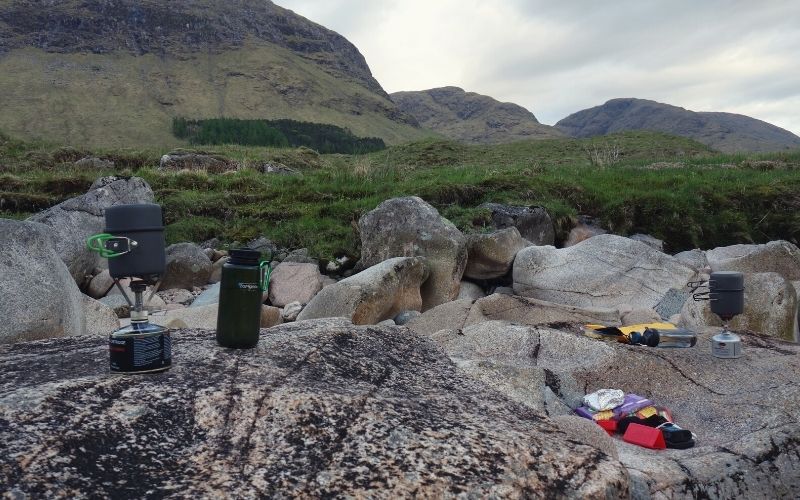
Water Boil Time & Fuel Efficiency
Assessing a stove’s performance requires considering both the time it takes to boil water and the amount of fuel consumed in the process. After all, if a stove rapidly boils water but excessively consumes fuel, you’ll need to carry extra fuel for anything more than having a few cups of coffee during your trip.
As a general rule, integrated stove systems boil water quicker than the rest of the bunch, and alcohol or wood-burning stoves are the slowest. The Jetboil Flash, for example, can boil 1 liter of water in 3 minutes and 20 seconds, whereas the Solo Lite – our review’s only wood-burning stove – will require around 10 minutes of patience before enjoying your morning brew.
The speediest boiler in our review, the BRS 3000T, boils 1 liter of water in under 3 minutes but is a far poorer performer than the Jetboil Flash or MSR Windburner when there’s any semblance of wind.
Alcohol and kerosene take considerably longer than other fuels to boil. The MSR WhisperLite, for example, can boil 1 liter of water in 3.5 minutes when running on white gas but takes almost 4.5 minutes when running on kerosene.
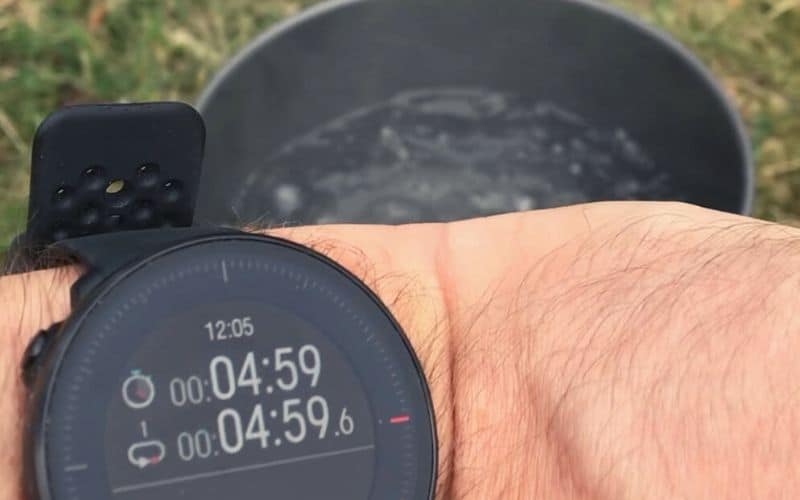
Burner Power: BTUs
A stove system’s burner output or power is measured in BTUs (British Thermal Units), the energy needed to heat 1 pound of water by 1 degree Fahrenheit. A higher BTU value signifies a stronger stove output.
BTUs give you a general idea of how effective a backpacking stove system will be. However, they should not be taken as the sole indicator of power or efficiency, because size and wind resistance will also come into play.
This is demonstrated by the Soto Amicus canister stove, which has a rating of 11,000 BTUs but also one of the slowest boil times (4 mins 42 secs), and the Primus Essential Trail, at only 8,600 BTUs can boil water in 3 mins and 30 secs.
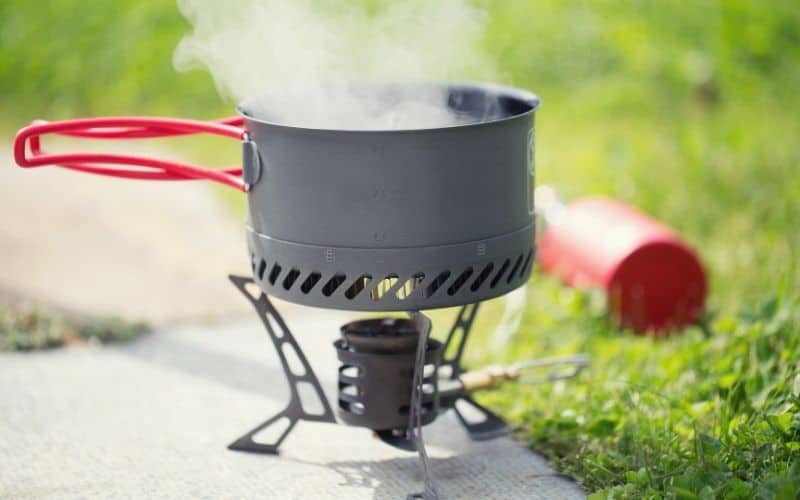
Weight & Packability
The importance of a stove’s weight and packability varies based on your camping style. For car camping, these factors may not be significant. However, if you plan on backpacking, thru-hiking, or remote backcountry camping, minimizing weight and bulk becomes a top priority.
Bear in mind, however, that there’s often a trade-off between weight savings and other desirable attributes such as power, wind resistance, and convenience.
The lightest backpacking stoves (usually alternative-fuel stoves or folding camping stoves) typically offer the least wind protection, aren’t the most fuel-efficient, and of course, don’t include the pot you’ll put your fluids/eats in. On the other hand, heavier all-in-one systems are generally best in windy conditions, are fuel-efficient, and have an integrated pot for your grub/drinks.
The lightest stove we reviewed was the BRS 3000T, a non-integrated system that weighs a piddly 1 oz. The MSR WindBurner, which is an integrated system, weighs the heaviest at 15.5oz
It’s also worth bearing in mind that while integrated stove weight includes the overall weight of the burner, pot, and heat exchanger, the weight of non-integrated models refers only to the weight of the stove/burner. It is therefore wise to factor in the added weight of a pot (and windshield) before deciding to buy.
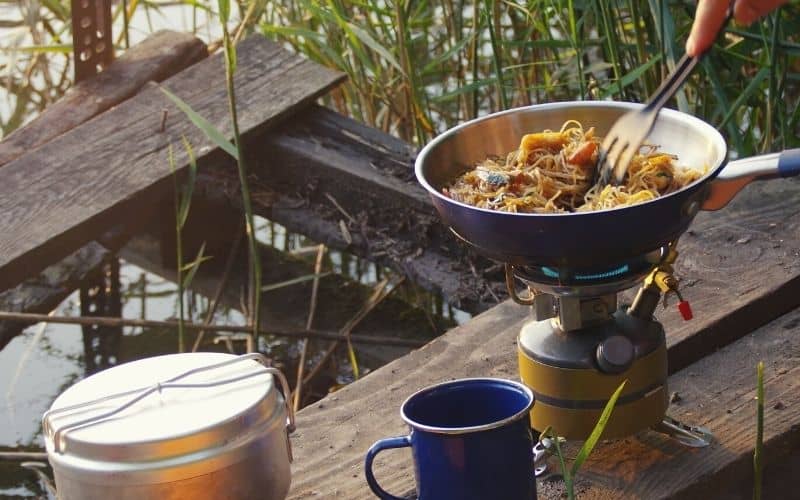
Integrated Ignition System
An integrated ignition system, also known as a “push-button” or “Piezo igniter,” indicates the stove has a built-in button that ignites the flame when pressed. This handy feature eliminates the need for matches and is particularly convenient in wet and/or windy conditions. While it may slightly increase the overall weight of the device, the convenience it offers makes it worthwhile.
In our review, the Jetboil Flash, Jetboil MiniMo, and Soto Amicus have integrated ignitions.
Simmer Control
Simmer control enables more precise regulation of the stove’s output. While unnecessary for those solely boiling water, it can be a game-changer for campers who like to cook more intricate or elaborate meals.
Most screw-on and hose-fed stoves offer simmer control via the gas-release dial on the burner. With all-in-one systems, on the other hand, there’s a fifty-fifty split between those that have and those that don’t.
In our review, the following stoves have simmer control: MSR PocketRocket 2, BRS 3000T, Jetboil MiniMo, MSR WindBurner, Soto Amicus, and the Primus Essential Trail.
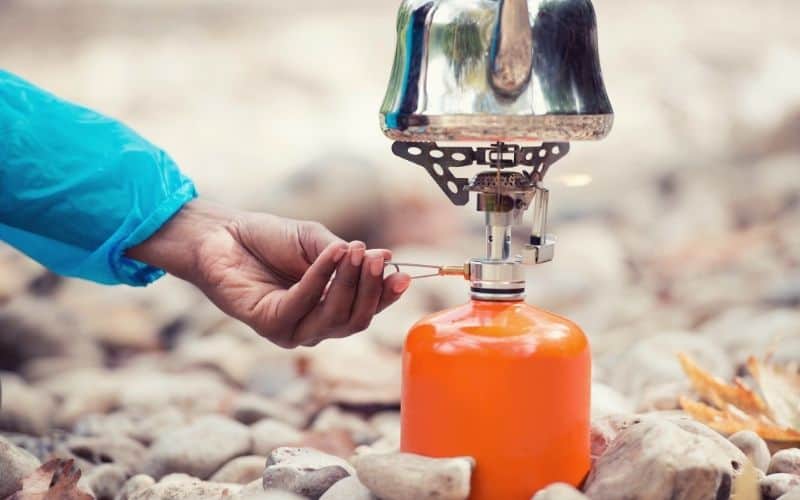
Wind Protection
No factor increases a stove’s efficiency more than the ability to shield it from the wind. Even a slight breeze can redirect the force and heat of the flame away from your pot, making wind protection crucial when selecting your stove.
Integrated systems are by far the best performers in windy conditions because they are designed with the burner enclosed within a heat exchanger that traps excess heat and delivers it directly to the pot.
With non-integrated systems, you can buy a separate windscreen that both blocks out the wind and reflects the heat from the flame, which can seriously improve cooking time. However, even with separate windscreens, non-integrated systems are still usually less effective in the wind than integrated systems.
Finally, because hose-fed canister stoves sit lower to the ground, they’re usually more stable and better performers in windy conditions than screw-on models.
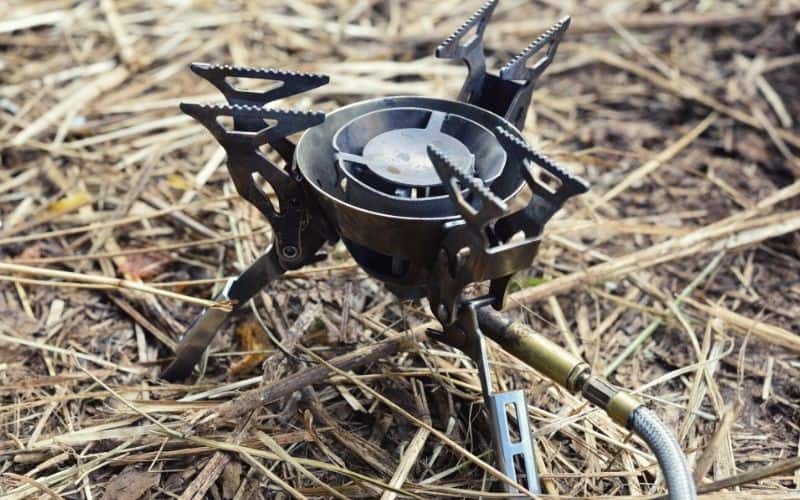
Stability
A backpacking stove’s stability depends on the width and design of the pot supports, and for canister stoves, the presence or absence of canister supports. Good stability is crucial, particularly when using larger pots for group cooking and in windy conditions.
Screw-on stoves are generally the least stable option, mainly because the pot isn’t locked onto the burner and sits on top of the leg supports where it’s exposed to the wind and liable to slide off. Given this, the wider the leg supports are, the more stable the system will be.
The non-integrated systems in our review that have pot support wide enough to support larger cooking vessels are the MSR PocketRocket 2, Soto Amicus, and BRS 3000T.
More stable options are remote (aka “hose-fed”) systems like the MSR WhisperLite, which sits lower to the ground than screw-on canister models and uses a robust tripod stand to support the burner.
All of the integrated stove systems in our review (the Jetboil Flash, Jetboil MiniMo, and MSR WindBurner) have tripod leg supports that provide a solid base for the canister. And because the burner locks onto the pot and canister in these systems, they are by far the most stable of the bunch.
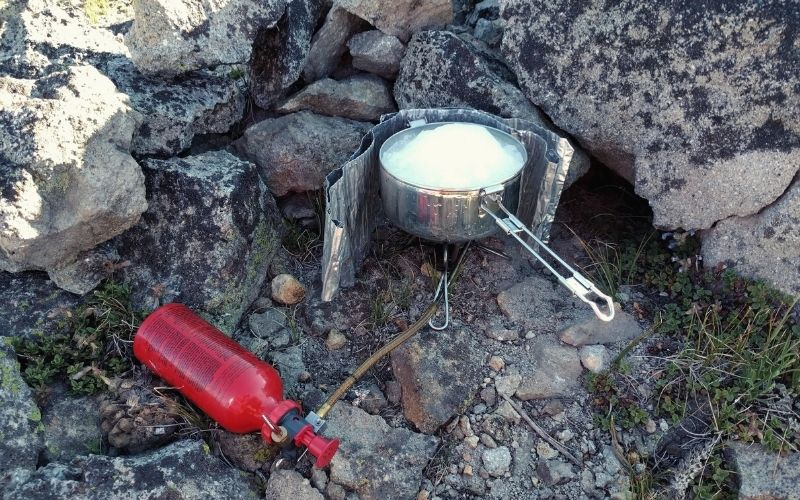
Cooking At Altitude & In Cold Weather
Certain types of fuel perform better than others at varying altitudes and weather conditions, making where and when you plan to use your stove important considerations.
In sub-zero conditions, isobutane and propane often fail to vaporize, meaning they’re unable to travel from the canister to the burner, and at high altitudes, gas canisters can depressurize. In both cases, you’ll be left with either a very weak flame or no flame at all.
If you plan on hiking at higher elevations or in winter conditions we recommend opting for a stove that runs on white gas or other liquid fuels. These are the most effective and reliable options in both situations. The only liquid-fuel stove on our list is the MSR WhisperLite.
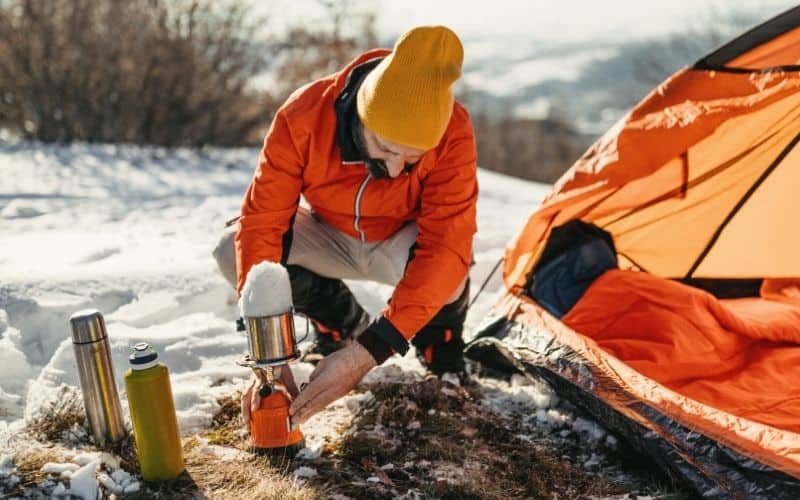
Backpacking Stove Reviews: The Verdict
Our top pick for the best backpacking stove is the MSR PocketRocket, weighing only 2.7 oz. With an impressive boil time, simmer control, and Windclip protection, this little package all comes at a very affordable price.
If you want to get a bit more back to nature with your stove then we love the Solo Lite wood-burning stove. It may have a much longer boil time than other models on the list but for extended stays in the wilderness not having to pack and carry your fuel source is a big bonus!
And if you are don’t mind some extra ounces for a more ‘advanced’ backpacking stove then the ever-popular Jetboil Flash deserves a mention. With a rapid 200-second boil time per liter, a push-button igniter, and a fuel-canister stabilizer for windier conditions, if you can afford the higher price tag the Flash is definitely worth a look in.
If you liked this article or have any questions, let us know in the comments box below. And if you’d like to share this post with your friends, please feel free to do so!
